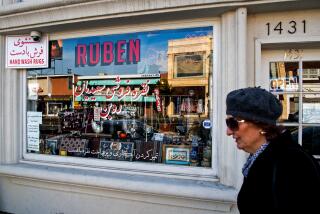In Tehran, two lives redesigned
Tehran
A wealthy, fashionable woman from north Tehran, Sudaveh had no idea how to act when the morality police would show up at her clothing factory in the first years of the Iranian revolution.
Zarir, her young assistant from the pious slums of south Tehran, knew exactly what to do. “Don’t go in there!” Zarir would tell the men as Sudaveh rushed to cover up in adherence to strict Islamic dress codes. “Madame doesn’t like to be disturbed during her prayers.”
Or, “Don’t look inside that drawer” where the well-traveled Sudaveh kept foreign design catalogs that would be deemed risque. “She might have pictures of herself without her head scarf!”
While Zarir helped Sudaveh navigate the intricacies of the Islamic Republic, Sudaveh helped Zarir transform herself from a homebound victim of domestic violence to a businesswoman who stood up to her ex-husband and strict traditional family.
Over nearly two decades, the two women from two different Irans became friends. The threads of their lives became interwoven. The fabric of their nation changed. Their clothing business grew into a small empire.
“This is a place where I got to know them,” Sudaveh said, referring to Iran’s religious poor, “and they got to know us.”
After the 1979 Islamic Revolution, Iran turned inside out. Streets, once bustling with prostitutes and drunken revelers, became as somber as mosques during afternoon prayers. Homes, once refuges from the revelry and decadence of the city, became impromptu bars and nightclubs.
The revolution also upended Iran’s once-inflexible class system. Wealthy families lost status and income, and many moved abroad. Pious and poor families made their way up the social ladder. Economic realities sent women into the workforce.
In this transformed world, Sudaveh and Zarir came together.
Before the revolution, Sudaveh worked as a deputy to the head of Iran’s state-owned Agricultural Bank, an elite post she got through connections and a family background that bordered on the aristocratic. But like many of her class, she was pushed out of her job.
A restless and wiry woman then in her mid-30s, she began going through her options. She wanted to earn money for her family, stay busy and keep her distance from the newly empowered class of pious bureaucrats who enforced Islamic codes of behavior.
“I wasn’t the type to sit home,” she said. “I had to work.”
She decided to get into the clothing business, specifically children’s outfits, to avoid the troubles that accompany anything to do with women’s fashion in Iran.
She sketched T-shirt designs, had them produced cheaply at workshops in downtown Tehran and, along with a friend named Haleh, canvassed vendors.
“My husband considered it a game,” said Sudaveh, who asked that neither their last names nor the name of her company be published for fear of jeopardizing the firm and its workers. “He used to make fun of me.”
She ran into numerous hassles in the male-dominated business.
“At first, work was very hard,” she said. “The stores would try to rip us off. They thought I was some simple rich woman whose husband is letting her doing this to keep her busy. I had to show that they couldn’t rip me off, that I knew what I was doing.”
Her business grew, and Sudaveh took a chance. She bought some equipment, hired a few workers and began producing the clothes herself. At the time, it was rare for a woman to run a factory, and it immediately aroused the suspicion of the morality police. They started making visits.
The Islamic Republic’s restrictions on dress and social behavior barely affected Zarir’s south Tehran neighborhood during the 1980s, when almost all women wore black chadors covering everything but their faces and hands, and parents arranged weddings for their children.
Zarir came from a strictly religious family, and even during the secular rule of Shah Mohammed Reza Pahlavi, she was sent to an Islamic school in south Tehran.
At 16, she was married off. Her husband was abusive and divorced her; he won custody of their two children six years later. The divorce was a mark of shame for her and her family. To make matters worse, her former husband refused to let her see her son and daughter.
With no means to look after herself, she persuaded her conservative father to let her look for a job. That’s when she met Sudaveh. It was the late 1980s.
“When I came here, I was in a really bad state,” said Zarir, now in her early 40s and manager of the workshop. She is the physical opposite of Sudaveh, beefy arms, round cheeks and a booming voice that rises above the workshop’s rumble and clatter.
Her reluctant father was impressed with Sudaveh and agreed to let Zarir work at the factory as long as she stayed upstairs and did not go downstairs where the men worked.
Sudaveh soon discovered her new employee’s hidden talents.
“Because she understood these religious people, when they came here and I was terrified she would step forward to answer,” Sudaveh said.
She’d lost her business partner, Haleh, after a run-in with the morality police. They had stormed in and found a clothing catalog with photographs of women wearing bikinis in a desk drawer; Haleh was locked up in prison with junkies and armed robbers. She left Iran soon afterward.
“You have to answer them quickly,” Zarir said. “If they ask, ‘Why are you wearing makeup?’ You say, ‘I don’t wear makeup for men; I wear it for women.’ If they say, ‘Your socks are too thin,’ you say, ‘But my hijab is long.’ ”
Once an official from the morality police, formally called the Office of Public Places, came in and began quizzing her about her boss, asking whether she mistreated her employees. “No,” Zarir says she told him, “but she’s a little prickly. She doesn’t like any noise when she’s praying.”
Sudaveh, who favors tight designer jeans and open-toe high-heel pumps, found the help indispensable.
“I didn’t even know how to wear my hijab,” she said. “I had no one in my family teach me how. Not even my grandmother wore hijab.”
After Sudaveh learned of her employee’s tale of heartbreak, she gave her some sophisticated uptown advice: discreetly befriend her ex-husband’s new wife, and offer to take care of the children now and then.
It worked. Soon Zarir and the second wife were conspiring, getting her the time with her children that had been denied by their father and the Islamic courts.
When the second wife became gravely ill, she entrusted both women’s children to Zarir while the husband was at work.
“It was a great lesson for me,” she said. “I learned to get what I needed.”
Zarir became impressed with Sudaveh’s social skills. Although conservatives derided people from her class as Western stooges, Zarir found her boss’ world attractive. “I’ve never seen a man treat a woman from their family the way my husband treated me,” she said.
Sudaveh hired more women, who now total 12 of her 40 employees. But she was frustrated by their refusal to interact with her male workers. They wouldn’t even look at the men and shrieked if they came close to touching. If a woman wanted to hand some needlework she’d done to a man assembling shirts, she’d find Sudaveh to do it.
“It was hurting the bottom line,” Sudaveh said. “A group effort means a group.”
One day some years ago, she gathered all the women working in the factory’s upstairs rooms. “I said, ‘I want to send you downstairs.’ ”
She led them down the steps. “I said, ‘You won’t put your head down. You’ll raise your head and look at the men in the eyes.’ ”
The next day, she made them do the same thing, and then again the day after that. Within a few months, an easy informality set in. The men and women began addressing each other by their first names as they worked side by side.
The men were forced to behave themselves, curb their language and keep their work spaces clean. One employee livened up the workshop by bringing in parakeets. They chirp as Iranian pop music plays in the background.
“Now they’re so normal with each other, it’s like nothing,” said Sudaveh, crossing her legs and smiling with satisfaction. “No one quit. They got used to it.”
As the years went by, Iranian society continued to change. People began moving from villages and farms to big cities such as Tehran, Tabriz and Mashhad, and cramming into tiny apartments.
Couples had fewer children, two or three instead of the six or seven common at the beginning of the revolution, according to the United Nations.
Parents doted on their children, and high-end clothes for them became a lucrative business.
Seven years ago, Sudaveh opened her own shop, with her own brand.
“Most store owners know nothing about products, or fashion,” she said.
It did well, and she opened another store.
Sudaveh’s daughter Ghazaleh finished her studies at the university and began working for her mother. She hired a software programmer to set up a computer inventory system, putting bar codes on every outfit, giving the company production and tracking capability.
The business that Sudaveh’s husband once viewed as a lark has expanded to about a dozen stores nationwide, generating millions of dollars in annual revenue. Sudaveh bought a condominium in Toronto. Zarir put her daughter through college.
The morality police still come around, though they are more a nuisance these days than a threat; they will shutter shops -- but temporarily -- when a saleswoman doesn’t comply with Islamic dress codes.
Recently, Zarir’s father fell ill and was in a hospital. She went to visit him, sitting by his bed. A business associate came in, and he introduced her.
“This is my daughter, the one who works,” he said with pride, and Zarir realized how far they’d come.
--
More to Read
Sign up for Essential California
The most important California stories and recommendations in your inbox every morning.
You may occasionally receive promotional content from the Los Angeles Times.
![LOS ANGELES, CA - JUNE 17: [Cody Ma and Misha Sesar share a few dishes from their Persian Restaurant Azizam] on Monday, June 17, 2024 in Los Angeles, CA. (Ethan Benavidez / For The Times)](https://ca-times.brightspotcdn.com/dims4/default/7ffc7f6/2147483647/strip/true/crop/5110x3417+306+0/resize/320x214!/quality/75/?url=https%3A%2F%2Fcalifornia-times-brightspot.s3.amazonaws.com%2F79%2Fdc%2F4d29255545f5b9813315901692bc%2F1459972-fo-azizam-review20-eba.JPG)









